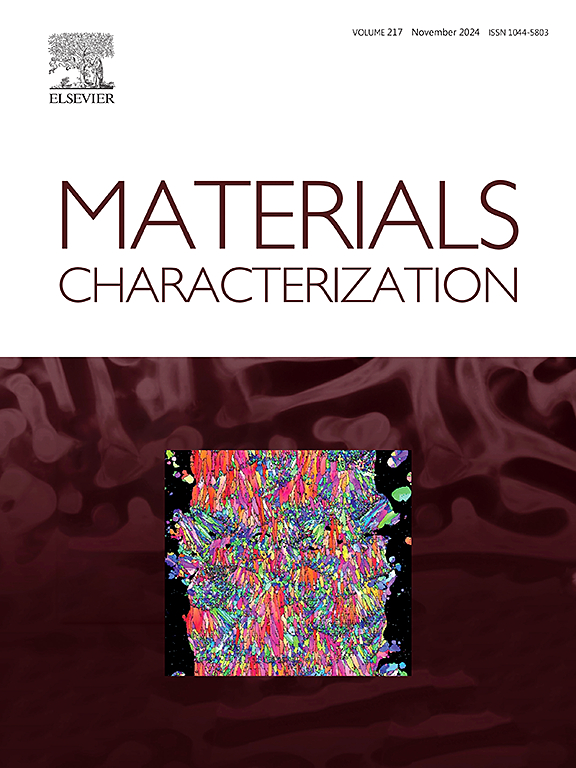多合成孪晶TiAl晶体对称倾斜[01¯1](511)Σ27晶界的原子结构和分子动力学模拟
IF 4.8
2区 材料科学
Q1 MATERIALS SCIENCE, CHARACTERIZATION & TESTING
引用次数: 0
摘要
弄清变形过程中晶界的结构演变对深入认识金属间化合物的力学性能具有重要意义。本研究利用像差校正透射电镜和分子动力学模拟研究了具有L10结构的γ-TiAl中对称倾斜[01¯1](511)Σ27 GB的原子结构、形成机制和变形行为。在拉伸变形过程中,由于孪晶-孪晶相互作用,形成了Σ27 gb连接三个< 011 > {111}Σ3 gb。Σ27 GB由周期性排列的GB结构单元组成。由于γ-TiAl的有序原子结构,相邻的两个GB结构单元之间存在(1/4)[01¯1]的晶体位移。通过分子动力学模拟研究了Σ27 gb在300k和1000k下的变形行为。单轴拉伸荷载分别沿平行于和垂直于GBs方向施加。发现叠加断层的形成是Σ27 GBs在平行和垂直拉伸作用下的主要变形机制。在平行张力加载下,层错容易滑动,而在垂直张力加载下,由于层错网络的形成,层错更为稳定。温度对层错密度有显著影响,而其作用取决于拉伸加载的方向。本文章由计算机程序翻译,如有差异,请以英文原文为准。
Atomic structure and molecular dynamics simulation of a symmetrical tilt [01¯1](511) Σ27 grain boundary in polysynthetically twinned TiAl crystals
Clarifying the structural evolution of grain boundaries (GBs) during deformation is important to deeply understand the mechanical properties of intermetallic compounds. In this study, the atomic structure, formation mechanism, and deformation behavior of a symmetrical tilt [01] (511) 27 GB in γ-TiAl with the L10 structure have been investigated by aberration-corrected transmission electron microscopy and molecular dynamics simulations. The 27 GBs were formed to connect three 〈011〉 {111} 3 GBs in polysynthetically twinned TiAl crystals due to the twin-twin interactions during tensile deformation. The 27 GB was composed of periodically arranged GB structural units. There was a crystal displacement of (1/4) [01] between two neighboring GB structural units due to the ordered atomic structure of γ-TiAl. The deformation behaviors of the Σ27 GBs at 300 K and 1000 K have been investigated by molecular dynamics simulations. The uniaxial tension loading was applied along the directions parallel and perpendicular to the GBs, respectively. It was found that the formation of stacking faults was the dominant deformation mechanism of the Σ27 GBs under both parallel and perpendicular tension loading. The stacking faults were easy to slide under parallel tension loading, while they were more stable under perpendicular tension loading due to the formation of stacking fault networks. The temperature significantly affected the density of stacking faults, while its role depended on the direction of tension loading.
求助全文
通过发布文献求助,成功后即可免费获取论文全文。
去求助
来源期刊

Materials Characterization
工程技术-材料科学:表征与测试
CiteScore
7.60
自引率
8.50%
发文量
746
审稿时长
36 days
期刊介绍:
Materials Characterization features original articles and state-of-the-art reviews on theoretical and practical aspects of the structure and behaviour of materials.
The Journal focuses on all characterization techniques, including all forms of microscopy (light, electron, acoustic, etc.,) and analysis (especially microanalysis and surface analytical techniques). Developments in both this wide range of techniques and their application to the quantification of the microstructure of materials are essential facets of the Journal.
The Journal provides the Materials Scientist/Engineer with up-to-date information on many types of materials with an underlying theme of explaining the behavior of materials using novel approaches. Materials covered by the journal include:
Metals & Alloys
Ceramics
Nanomaterials
Biomedical materials
Optical materials
Composites
Natural Materials.
 求助内容:
求助内容: 应助结果提醒方式:
应助结果提醒方式:


